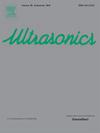An automatic Doppler angle analysis method for interventional blood flow velocity calibration
IF 3.8
2区 物理与天体物理
Q1 ACOUSTICS
引用次数: 0
Abstract
Quantitative monitoring of blood flow velocity, is helpful to accurately evaluate the hemodynamic status of patients. However, the traditional blood flow velocity calibration method depends on manual operation, and it is not suitable for interventional blood flow velocity measurement. In this study, a new intravascular ultrasound (IVUS) catheter design combined with an automated Doppler velocity angle calibration method was investigated. Our ultrasound catheter will not have non-uniform rotation distortion (NURD), so the original IVUS images will be directly used to analyze Doppler angle. The deflection of ultrasound catheter is analyzed and simulated, and the formulas for estimating Doppler angle and calibrating blood flow velocity are given. The U-Net-based model segmented the lumen region from the image, and then used an ellipse to quickly fit the lumen boundary. A hemodynamic circulation circuit was constructed, and the measurements of ultrasound catheters and commercially available instruments were compared. The model achieves good segmentation performance, Dice similarity coefficient is 99.464%,Jaccard index is 98.934%, Hausdorff distance is 0.15780 mm. Statistical tests showed that the cosines of the true and estimated Doppler angles have a good correlation and consistency. The mean absolute and relative errors of the estimated Doppler angles are 1.49374° and 7.42654%, respectively. The mean relative error of calibrated blood flow velocity was 8.453925%. This study may have a good application prospect in ultrasound hemodynamic monitoring.
介入血流速度标定的自动多普勒角分析方法
定量监测血流速度,有助于准确评价患者血流动力学状态。然而,传统的血流速度校准方法依赖于人工操作,不适合介入血流速度测量。在这项研究中,研究了一种新的血管内超声(IVUS)导管设计与自动多普勒速度角校准方法。我们的超声导管不会有非均匀旋转畸变(NURD),因此将直接使用原始IVUS图像来分析多普勒角。对超声导管的偏转进行了分析和模拟,给出了多普勒角的估计和血流速度的标定公式。基于u - net的模型从图像中分割出流明区域,然后使用椭圆快速拟合流明边界。建立了血流动力学循环回路,并比较了超声导管和市售仪器的测量结果。该模型具有良好的分割性能,Dice相似系数为99.464%,Jaccard指数为98.934%,Hausdorff距离为0.15780 mm。统计检验表明,真实多普勒角和估计多普勒角的余弦值具有良好的相关性和一致性。估计多普勒角的平均绝对误差和相对误差分别为1.49374°和7.42654%。校正后血流速度的平均相对误差为8.453925%。本研究在超声血流动力学监测中具有良好的应用前景。
本文章由计算机程序翻译,如有差异,请以英文原文为准。
求助全文
约1分钟内获得全文
求助全文
来源期刊

Ultrasonics
医学-核医学
CiteScore
7.60
自引率
19.00%
发文量
186
审稿时长
3.9 months
期刊介绍:
Ultrasonics is the only internationally established journal which covers the entire field of ultrasound research and technology and all its many applications. Ultrasonics contains a variety of sections to keep readers fully informed and up-to-date on the whole spectrum of research and development throughout the world. Ultrasonics publishes papers of exceptional quality and of relevance to both academia and industry. Manuscripts in which ultrasonics is a central issue and not simply an incidental tool or minor issue, are welcomed.
As well as top quality original research papers and review articles by world renowned experts, Ultrasonics also regularly features short communications, a calendar of forthcoming events and special issues dedicated to topical subjects.
 求助内容:
求助内容: 应助结果提醒方式:
应助结果提醒方式:


